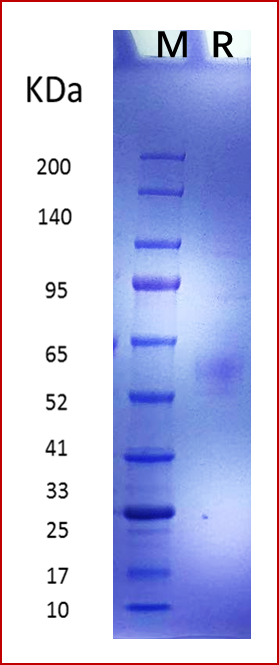- 产品描述
- 产品数据
-
- 商品名称: Recombinant Human Wnt5a
- 商品编号: WN5-H100F
- 物种: Human
- 表达系统: HEK293
- 标签: HIS
- 纯度: >90%
- 活性: 细胞活性
产品描述(DESCRIPTION)
Source
Human embryonic kidney 293 cells, HEK293
Gln38-Lys380 with a HIS tag at the C-terminal
UniProtKB# P41221
Species
Human
Predicted Molecular
Mass40 kDa
质量属性(SPECIFICATIONS)
SDSPAGE
The protein migrates as 60 kDa under reducing (R) condition (SDS-PAGE) due to glycosylation.
Purity
>90% as determined by SDS-PAGE.
Formulation
Lyophilized from 0.22 μm filtered solution in PBS, pH7.4, 5% trehalose and
0.01 % Tween 80 were added as protectant before lyophilization保存与使用(PREPARATION AND STORAGE)
Shipping
The product is shipped with Blue ice.
Reconstitution
Reconstitute at 100 μg/mL in sterile PBS containing at least 0.1% human or bovine serum albumin.
Storage
For long term storage, the product should be stored at lyophilized state at -20°C,avoid repeated freezethaw cycles.
Stability
>12 months, under -20°C conditions before reconstitution.
>6 months, -80 °C under sterile conditions after reconstitution.背景介绍(BACKGROUND)
Wnt-5a is a 44‑50 kDa member of the Wnt family of proteins . Based on its activity towards C57Mg mammary epithelium, it is classified as a nontransforming Wnt. Human Wnt‑5a is synthesized as a 380 amino acid (aa) precursor that contains a 37 aa signal sequence, a 25 aa prosegment, and a 319 aa mature region . The mature region has 24 cysteine residues that form multiple intrachain disulfide bonds, plus four N‑linked glycosylation sites that are utilized for proper secretion . There is also a palmitate adduct at Cys104 that is essential for activity, and a potential palmitoleic acid modification at Ser244 that may also contribute to secretion . One alternative start site is reported at Met16. Over aa 38‑380, human and mouse Wnt‑5a are identical in amino acid sequence . Cells known to express Wnt‑5a include brainstem astrocytes, mammary epithelium, CD34+ primitive progenitor stem cells, chondrocytes, CD34- pericytes and vascular smooth muscle cells , plus mesenchymal cells at various sites . There are multiple receptors for Wnt‑5a. These include Fzd-1, -2,
-3, -4, -5, and -7, Ror2, LRP6, Ryk and sFRP1 . All these molecules function within the context of a larger number of “co‑factors” that regulate signaling by the Wnts. Initially, it was suggested that there were three pathways for Wnt signaling; a beta -catenin-mediated canonical pathway, and two noncanonical pathways described as the Wnt/JNK (PCP) pathway and the Wnt/Ca++ pathway . And it was assumed that various Wnts could be accommodated by these classifications. At present, it is now recognized that individual Wnts, through various combinations of receptor complex subunits, can have diverse effects, perhaps even within the same cell . Further complexity is introduced by the fact that Xenopus Wnt‑5a and Wnt‑11 are known to form bioactive heterodimers following Tyr sulfation. Thus, predicting the activity of Wnt‑5a, or any other Wnt, on any cell type will require substantial insight into the interaction between all the extracellular, cell surface and intracellular components of the Wnt signaling system. -

4%-20% SDS-PAGE Result Recombinant Wnt5a, 2ug reducing

